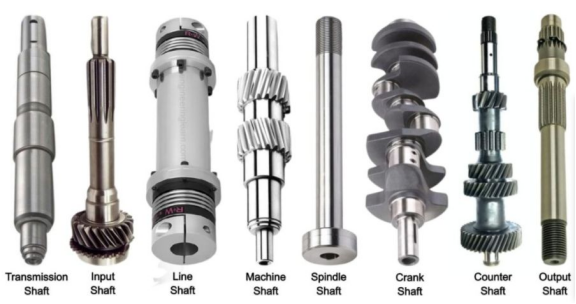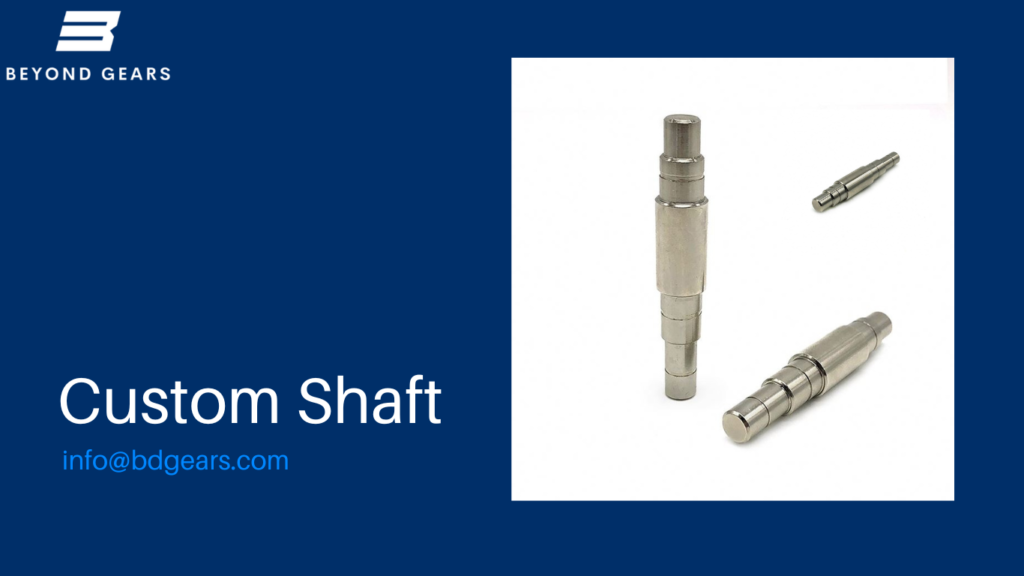What is a shaft?
A shaft is essentially a rotating component of any machine, typically having a circular cross-section, used to transmit power from one part to another or from a power source to a power-absorbing mechanism. To transmit power, one end of the shaft is connected to the power source, while the other end is connected to the machine. Shafts can be solid or hollow as needed, with hollow shafts aiding in reducing weight and offering advantages.

General Description of Shafts
Shafts are crucial components used in machinery. They support rotating elements such as pulleys and gears, supported by bearings within the rigid machine housing. Gears and pulleys mounted on the shafts contribute to the transmission of motion.
Many other rotating components are keyed onto shafts. They endure bending moments and torques due to reactions from supported components and power transmission.
Shafts always have circular cross-sections and can be either hollow or solid. They can be classified as crankshafts, straight shafts, articulated shafts, or flexible shafts, although straight shafts are typically used for power transmission.
Shafts are usually designed as steep cylindrical bars, hence they have varying diameters along their length, although shafts with constant diameters are easier to manufacture.
The magnitude of stress in stepped shafts varies with their length. Shafts with uniform diameters are unsuitable for disassembly, assembly, maintenance, and these shafts introduce complexity when securing components, especially bearings, to them.
Types of shafts
Transmission Shafts
These shafts are stepped shafts used to transfer power from one source to another in machinery that absorbs power. Gears, pulleys, or belt pulleys are mounted on the stepped portions of the shaft for transmitting motion.
Examples: Countershafts, line shafts, lay shafts, and shafts in all factories.
Machine Shafts
These shafts are located internally within components and are integral parts of machinery.
Example: The crankshaft in an automobile engine is a machine shaft.
Axles
These shafts support rotating components such as wheels and may be mounted in housings with bearings, but the axle itself is non-rotating. They are primarily used in vehicles.
Example: Axles in automobiles.
Main Shaft
These are the rotating parts of machinery that hold tools or workspaces. They are short shafts used in machines.
Example: The spindle in a lathe.
Materials for Shafts
Low carbon steel is commonly used for shafts. Alloy steels such as nickel-chromium, nickel, and chromium-vanadium steel are used for higher strength requirements. They are formed through processes like hot rolling, cold drawing, and grinding. Common grades of carbon steel used for standard shafts include 50C12, 50C4, 45C8, and 40C8.
Materials used for shafts should possess the following characteristics:
- High strength
- High wear resistance
- Heat-treatable properties
- Good mechanical properties
- Low notch sensitivity coefficient
Standard Dimensions of Shafts
Machine Shafts
Up to 25 millimeters with a pitch of 0.5 millimeters.
Transmission Shafts
Standard dimensions of shafts – pitch
25 millimeters to 60 millimeters – pitch of 5 millimeters;
60 millimeters to 100 millimeters – pitch of 10 millimeters;
110 millimeters to 140 millimeters – pitch of 15 millimeters;
140 millimeters to 500 millimeters – pitch of 20 millimeters.
Standard dimensions of machine shafts can reach up to 25 millimeters with a pitch of 5 millimeters. For shafts, standard lengths are 5m, 6m, and 7m, but typically taken between 1m and 2m.
Stresses in Shafts
The stresses induced in a shaft are:
Shear stress caused by torque transmission (due to twisting loads induced by torque);
Bending stress, either compressive or tensile, caused by forces acting on mechanical components such as pulleys and gears, as well as the weight of the shaft;
Combined stresses induced by bending and twisting loads.
The maximum allowable design shear stress is:
- Shaft with keyway allowance: 56,000 kN/m^2.
- Shaft without keyway allowance: 42,000 kN/m^2.
The maximum allowable bending stress is:
- Shaft with keyway allowance: 112,000 kN/m^2.
- Shaft without keyway allowance: 84,000 kN/m^2.
Manufacturing of Shafts
Shafts are manufactured using the hot rolling process. Compared to hot rolling, cold rolling results in higher strength of the shaft, but cold rolling can lead to high residual stresses, causing deformation of the shaft during machining. For manufacturing larger diameter shafts, the forging process is utilized.
After rolling, the shaft undergoes end machining, with one end of the shaft mounted on a fixture and the other end supported by the turret of a lathe. For precision machining of the shaft, the tool holder is fixed, and when the power is turned on, the chuck begins rotating the shaft.
Dial indicators are used to check the concentricity of the shaft before machining, and various operations such as turning, facing, grooving, taper turning, etc., are performed according to the requirements. The final machining process is best suited for mass production, CNC applications, etc. Alternatively, CNC double-ended machines with the shaft clamped between rotating tools and fixtures can be used for machining.
To achieve concentricity and roundness, rotating tools should be aligned on the centerline. This process is commonly employed for manufacturing transmission shafts and motors.
Shaft Power Transmission
As we know, shafts are used for power transmission, so the formula for calculating power transmission is: P=2πnT/60. Where P is the transmitted power (W); n is the speed in revolutions per minute (rpm); T is the torque in N·m.
Speeds for shafts used in various applications are as follows:
- Mechanical: 100~200;
- Woodworking machinery: 250~700;
- Textiles: 300~800;
- Light machinery workshops: 150~300;
- Auxiliary shafts: 200~600.
Shaft Design
Shafts can be designed for different loads through two different processes:
- Strength-based shaft design: Transmission shafts are typically subject to bending moments, torques, axial tension, and combinations thereof. Generally, the shaft bears a combination of torsional and bending stresses.
- Axial tension on the shaft: Tensile stress = P/A Where A = (π/4) x D^2, and D is the diameter of the shaft in mm.
- Bending stress on the shaft: Bending stress = (Mb x Y) / I Where Mb = bending moment, Y = D/2, and I = polar moment of inertia = (π x D^4) / 64
- Torsional stress on the shaft: Torsional stress = (Mt x R) / J Where Mt = torsional moment, R = D/2, and J = polar moment of inertia = (π x D^4) / 32
- Stiffness-based shaft design: If the shaft does not twist too much, the transmission shaft is referred to as rigid based on torsional stiffness.
- {Mt / J} = {(G x θ) / L} Where Mt = torque in N·mm, J = polar moment of inertia = (π x D^4) / 32, D = diameter of the shaft (mm), θ = torsional angle, and G = modulus of rigidity in N/mm².
Advantages and Disadvantages of Shafts
Advantages of Shafts
- They are less likely to get stuck.
- They require less maintenance compared to chain systems.
- They have high torsional strength.
- They have high polar moment of inertia values.
- They are very sturdy and less prone to failure.
- The internal shape of hollow shafts is empty, thus requiring less material.
- Hollow shafts are lighter in weight compared to solid shafts for the same torque transmission value.
- They have a high turning radius.
Disadvantages of Shafts
- They have power losses due to loose coupling.
- They vibrate during rotation.
- They generate continuous noise.
- High manufacturing and maintenance costs.
- High manufacturing complexity.
- Changing the speed of the shaft is not easy.
- Long downtime due to mechanical issues.
- Oil droplets from elevated shafts.
- Using elastic couplings (such as spring couplings) leads to speed loss between shafts.
- Repairing a shaft in case of failure requires a significant amount of time.
Thank you for reading this article, and we look forward to serving you with our exceptional gear solutions. Join our membership for more latest blogs. #BeyondGears
Read More:


